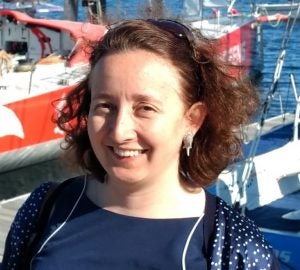Anabela Maia, Rhode Island College
Project Location
Rhode Island College
Project Description

Estuaries are areas of high kinetic energy dominate by winds and tides. Fish species that inhabit these ecosystems tend to have specializations to avoid being swept by currents and to minimize energy expenditure during swimming and while resting. When turbulence patterns change rapidly due to anthropogenic pressures – through channeling, high vessel traffic, changes in wind patterns – estuarine fish might not have time to adapt. Compounded with a rapid changing climate, changes in turbulence are likely to shift the metabolic demands of these species. The purpose of this project is to assess how turbulence experienced by fish in the Narragansett Bay influences fish performance. Body shape will be characterized by photographing specimens and digitizing landmarks on the body of the fish in multiple views.
Turbulence will be assessed by data collected by RI C-AIM deployed buoys. Natural and artificial turbulence seen in the Bay will be reproduced in the lab and fish performance will be measured to determine the effects of perturbations on representative fish species. To investigate which body shapes would be most suited to use in aquatic vehicles inspired by fish shape, 3D printed models of the best performing body shape attached to force sensors will be tested in a flow tank. Finally, models of fish species distribution based on lab performance will be superimposed with models of kinetic energy of Narragansett Bay to determine future displaced species with changes in turbulence.
This project involves primarily lab or computer work
Required/Preferred Skills
Knowledge of fish husbandry, some physiology background (e.g. animal or human physiology course)
Will students require their own transportation to field sites and/or other off-campus locations?
No
Additional Information
- Dr. Maia’s Research Page

 RI NSF EPSCoR is supported in part by the U.S. National Science Foundation under EPSCoR Cooperative Agreements #OIA-2433276 and in part by the RI Commerce Corporation via the Science and Technology Advisory Committee [STAC]. Any opinions, findings, conclusions, or recommendations expressed in this material are those of the author(s) and do not necessarily reflect the views of the U.S. National Science Foundation, the RI Commerce Corporation, STAC, our partners or our collaborators.
RI NSF EPSCoR is supported in part by the U.S. National Science Foundation under EPSCoR Cooperative Agreements #OIA-2433276 and in part by the RI Commerce Corporation via the Science and Technology Advisory Committee [STAC]. Any opinions, findings, conclusions, or recommendations expressed in this material are those of the author(s) and do not necessarily reflect the views of the U.S. National Science Foundation, the RI Commerce Corporation, STAC, our partners or our collaborators.